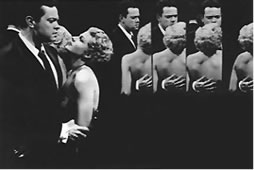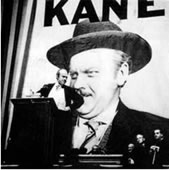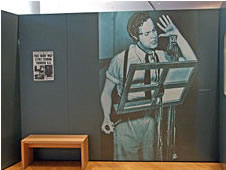HOLLYWOOD DIARY – Orson Welles
HOLLYWOOD DIARY
The Man Who Came In From The Radio
An Insight on Life and Times of Orson Welles by Naveen Gupt
1.In a recording studio, 1938 2. As Citizen Kane 3.In ‘Lady from Shangai’
In Hollywood and its sister city Bollywood; petty mean hearted men with deep pockets or brandishing imposing staffs in their hands, goad the genius. Independence and innovation are not invited unless called for. Much before the label ‘indie’ became synonymous with filmmakers with derring-do, one man fought with one hand tied, for over five decades to let the independent filmmaker survive and make his mark. This man who started the fire, incidentally was a rank outsider, and remained one throughout his life. Much before he was waylaid by the charms and ways of Lady Cinema, he was a templar knight of Lady Sound. He was Orson Welles; born as George Orson Welles in Kenosha, Wisconsin on May 6, 1915, as second son to an inventor father and a concert pianist & suffragette mother. When little Orson was 6, his alcoholic father separated from Beatrice Ives, his mother, and the affluent world in which Orson was born fell apart but under the wings of his artistic mother the boy imbibed life.
Orson Welles’s mother died of jaundice four days after his ninth birthday, and the young boy put down his ambition to be a musician. Orson lost his father, when 15 years old, the summer after his graduation from Todd School for Boys, Woodstock, Illinois. Welles in his later interviews never hid his guilt in neglecting his father. After a brief tour of Ireland where he bluffed his way on the stage of Gate Theatre, Dublin, pretending to be a Broadway star, he returned home and took to writing adaptations of Shakespeare. In New York, his revival of ‘Romeo and Juliet,’ caught the eye of John Houseman, who cast him as a lead in various productions of Federal Theatre Project-a part of Roosevelt’s work progress administration, which utilized unemployed theatre artistes for work by staging plays highlighting his ‘new deal.’
Welles asked to direct a project for Harlem’s American Negro Theater by John Houseman, had the ‘boy wonder’ casting an all-black ensemble in ‘Macbeth,’ moved to Haiti at the court of King Henri Christophe, with a setting of voodoo witch-doctors (please someone remind me of ‘Maqbool’ by Vishal Bharadwaj with Shah and Puri as witches!). The play became a landmark of African-American theatre, he further consolidated his image by mounting the farce ‘Horse eat hat’, and ‘Dr. Faustus,’ where he used light as a prime unifying scenic element on a dimly lit stage. He carried a coup of sorts when he staged pro-union ‘labour opera’ by Blitzstein, at Venice Theater at the last minute, instead of the usual venue at Maxine Elliot, blockaded by National Guardsmen, because of a worried Congress on the overt communist tones of the opera. The hallmark of Welles’s genius, in that his creativity was a spontaneous burst, full of panache and bluster, and with just a dash of improvisation, was fast becoming his calling card. He was a true genius; he never had to labour at anything he overtook.
Welles and Houseman now formed the Mercury Theatre, its actors included Joseph Cotten, Agnes Moorehead, Ray Collins, George Coulouris, Everett Sloane and other who would continue under Orson Welles baton on stage, radio and later films. Orson Welles was the first biggest superstar of the radio, which in 30s was bigger than the movies and there was no television. His ability as round the clock writer, actor, director, producer made him voice Lamont Cranston in ‘The Shadow’, the resounding success of which had CBS give him ‘The Mercury Theatre on the air,’ a weekly hour long show to produce at only 22,it was going to catapult Orson to international fame.
A day before Halloween, on Oct.30, 1938; 9 million Americans tuned into the performance of that evening- an adaptation of ‘War of the Worlds,’ by H.G. Wells, a science fiction novel about a Martian invasion of the earth. What they heard was ballistic and out of this world, Welles wrote and performed his play so that it sounded like news broadcast about an invasion from Mars. The dance music was interrupted by fake news bulletins about a flaming object landing on a farm near New Jersey! And although paid actors essayed the roles of news announcers, officials and members of administration that an unsuspecting audience was so taken in that people packed the roads, hid in cellars, loaded guns and wrapped their heads in wet towels as protection from Martian gas! For the first time in the history of electronic media people were stuck in a kind of virtual world in which fiction was confused for fact. News of the panic reported by genuine news reports created a national scandal, the public asking for a suitable broadcasting code to ensure a similar incident wouldn’t happen again. Today we live in a age of simulation-confusion, a tool essential for television’s survival; besides each ridiculous ‘breaking news’ is hard cash by sponsors!
Hollywood now berated Orson with offers, lures which independent minded Welles resisted but when RKO Pictures president George Schaefer offered $500,000 for a two picture deal with complete artistic control; it became the greatest contract ever offered to an untried director. Welles and the entire mercury Theatre moved to Hollywood.
For his first project Welles settled for an adaptation of Conrad’s ‘Heart of Darkness’, but the excessive budget and the anti-fascist tenor of story made RKO do a double turn. His second project, ‘The Smiler with the knife’, was not approved because the studio had no faith in Welles’s protégée Lucille Ball’s acting prowess. Hard pressed by RKO, Orson left his radio show to Houseman, and came up with ‘American,’ conceived with his fellow radio-writer Herman J. Mankiewicz; it would eventually become Welles first feature film, ‘Citizen Kane.’(1941). The film was mired in controversy from the seeding only. Mankiewicz, banished from the table of the great media baron William Randolph Hearst and his mistress Marion Davies, the actress, for being a perpetually drunk and notorious gossip based the film on an expose of Hearst’s life. But Welles wanting to create a complex character asked Mankiewicz to incorporate elements from lives of Joseph Pulitzer, Howard Hughes, Robert McCormick and the 300 pages of notes he had written on ‘Heart of Darkness’, in the screenplay. John Houseman was summoned to keep Mankiewicz sober. But the duo in their sly malice towards their young boss worked in cunning autobiographical allusions to Welles, particularly regarding his guardianship. Welles refused unfortunately to incorporate claims about the death of Film Director Thomas Ince being killed on an excursion on a Hearst yacht. Mankiewicz, ironically later lamented and wisely so, that if this material had been left in, Hearst would never have dared to make the public connection to his own life and would have left the film alone.
The completion of the script drew in legendary cinematographer Gregg Toland, who in a moment of bravado placed his Oscar on Orson Welles’s table as his calling card and asked for work! Welles with the entire Mercury group in tandem filmed, what is considered the greatest film ever made, by the critics the world over. During the 1950s young French film critics such as Francois Truffaut, Goddard, Chabrol and others were inspired by Welles ‘example to make their own films in keeping with ‘auteur theory’, and gave birth to Nouvelle Vague. The innovative elements of Welles’style exhibited in ‘Citizen Kane’ were: 1. Composition in depth: the use of extreme deep focus cinematography to connect distant figures in space. 2. Complex mise-en scene, in which the frame overflowed with action and detail. 3.Low angle shots that revealed ceilings making the characters dominant yet trapped in their destiny. 4. Long takes. 5. A fluid moving camera that expanded the action beyond the frame. 6. The creative use of sound as a transition device and to create visual metaphors.
The film was well received by the critics, but it faced distribution and exhibition problems due to the entire might of Hearst thrust against it, the media mogul made it sure that it fared poorly at the box-office. It garnered 9 Oscar nominations but snagged the only one for original screenplay for Mankiewicz and Welles. In the 1999 HBO movie, ‘RKO 281,’ John Malkovich as Mankiewicz reminds Liev Schreiber playing Welles – whether Welles will outdo himself at 26 ever again!
His second film, ‘The Magnificent Ambersons’, (1942) was an adaptation of Booth Tarkington’s novel and starred Cotten, Anne Baxter and Agnes Moorehead. At the editing stage RKO and theUS government, asked Welles to helm $1 million semi-documentary, ‘It’s all true,’ to shoot in South America. An unsuspecting Welles embarked on his mission not knowing the cleverly worked clauses that ensured that he had forfeited his rights of artistic control. 3 reels of footage from Welles’ original cut was lopped off, and yet the film remains the second greatest all American film ever made, and one of the top ten films ever made in, ‘Sight and Sound’s’ 1982 list. The film bombed at the box-office and Welles’ reputation suffered a deathblow, he was dismissed along with his cast from RKO! Welles now took an increasingly active role in American and international politics and used radio and journalism to communicate his forceful ideas widely. He delivered a hit with ‘The Stranger’,(1946), produced by legendary Sam Spiegel, who again despite Welles’ protests took to editing of the film. Welles was now convinced not to be a cog in a Hollywood studio ever and resumed his struggle for the total creative control.
His fortunes continued to waver, with success in radio, but flops on stage especially the musical, ‘Around the world in Eighty days.’ He agreed to helm the Columbia Pictures, ‘The lady fromShanghai,’ with his then estranged second wife, Rita Hayworth as co-star in 1947. Again the studio boss Harry Cohn, found the rough cut confusing and ordered extensive editing and reshoots. The film was a disaster at the time of its release in America, though widely acclaimed in Europe, however Hayworth finalized her divorce from a much-embarrassed Welles. In 1948, Welles convinced Republic Pictures to let him direct a low budget version of ‘Macbeth’, with papier-mache sets and cardboard crowns, it was another disaster. Welles now left US for Europe for an exile of 8 years to explore the possibilities of directing and producing films again, but the reality was that Hearst and FBI head honcho Hoover had him blacklisted in Hollywood, labeling him a communist.
After ‘Black Magic’ (1948), Welles appeared as the immortal Harry Lime in ‘The Third Man,’ written by Graham Greene and directed by Sir Carol Reed in 1949. His bravura performance with Cotton made the film an international hit, and in a poll carried out by BFI in 1999, it was considered the greatest British picture ever made. As luck would have it Welles turned down a percentage of the gross in exchange for a lump-sum advance. Orson Welles now took to channeling his money from acting roles into self-financed adaptation of, ‘Othello,’ which after two years of filming on location in Europe and Morocco, premiered at the Cannes Film Festival and won the Palm d’Or.
His return in 1956 to Hollywood was crowded with numerous appearances on radio and television (notably in ‘I love Lucy’) and films like ‘The Fountain of Youth’ and the ‘Man in shadow.’ In 1958, Universal gave him ‘Touch of Evil,’ at Heston’s suggestion. Welles guided old friends Cotton, Marlene Dietrich, Akim Tamiroff and himself; finishing on schedule and on budget. Out of the blue, the studio wrested the film from him, re-edited and reshot the exposition scenes to clarify the plot. Welles wrote a 58-page memo outlining the suggestions and objections, but the studio executives hacked another 30 minutes to make the film pacier. Even in its mutilated form, the film won the top prize at Brussels’ world fair. ‘Touch of Evil’, from its long-take opening of a car bombing to its denouement, reemphasized Welles’ overarching vision of the world where each human act has endless and unforeseen moral consequences. His adaptation of Kafka’s ‘The Trial’, left Truffaut disappointed but then Welles had finished the entire film on almost zero budget and on an abandoned railway station in Paris as improvised location. He completed his Shakespearean trilogy with a triumphant, ‘Chimes at Midnight’, fashioned from five of Shakespeare’s plays and a film in which he played true to life Falstaff.
‘The Immortal Story’,(1968) was for French television and his final completed film, ’F for Fake’(1973) was sweeping collage of documentary and staged footage, that investigated the thin line between reality and illusion, celebrated all tricksters- including its director, who had once wanted to be a magician.
In 1971,he was awarded an honorary Oscar for his superlative artistry and versatility in creation of motion picture. Welles sent his best friend John Huston to claim the award. Huston criticized the Academy for awarding Welles while they refused to give him any work. In 1975, AFI presented Welles with their third Lifetime Achievement Award (the other two being John Ford and James Cagney). In his later years Welles did any work, be it voicing of commercials on Radio& TV, Radio Serials and as host on Talk shows to realize funds for his projects. As a lecturer and storyteller, he had no equivalent even when serious obesity restricted his ability to travel. He died of a heart attack at his home in Hollywood, at 70, on October 10,1985.
At the time of his death, ‘The other side of the wind,’ an obvious autobiographical film he had been pursuing since 1970s remained unfinished. It was a story of a famous filmmaker, played by John Huston, struggling to find financing for his film, just as Welles was forced to do many times.
Sparkling genius is its own enemy! It makes the foolish look how dumb they actually are; this is the reason why a film making maverick like Orson Welles, who in words of Martin Scorsese was, “ responsible for inspiring more people to be film directors than anyone else in the history of cinema,’ remained an outsider in Hollywood, which did not allow him to make a greater picture than ‘Citizen Kane.’


